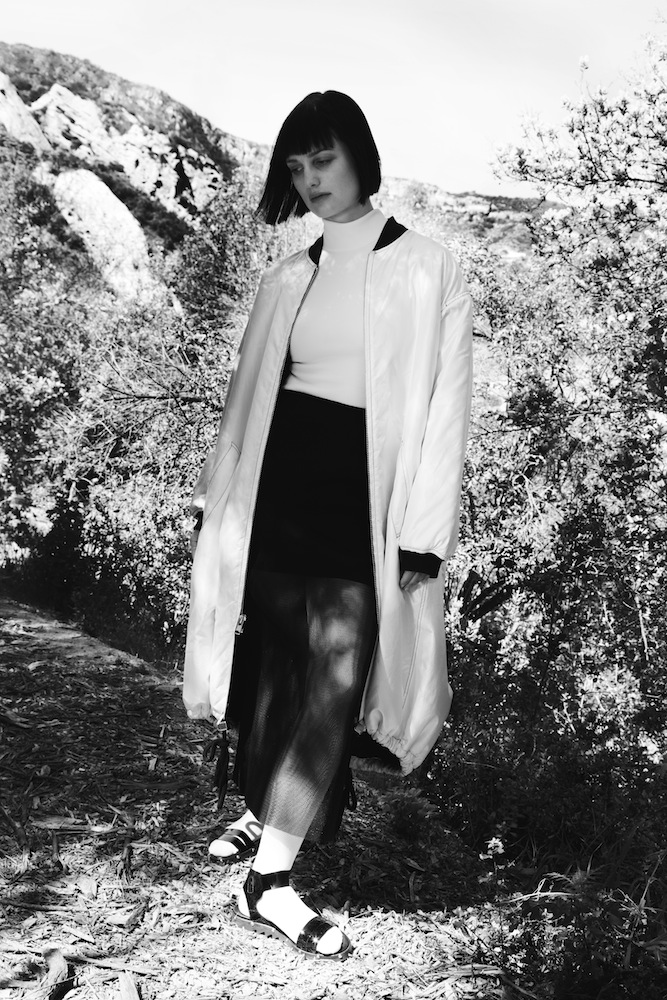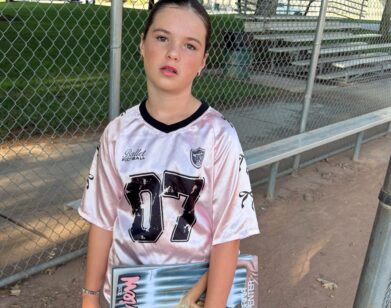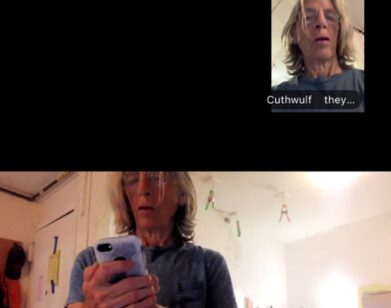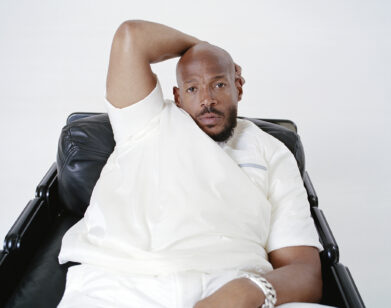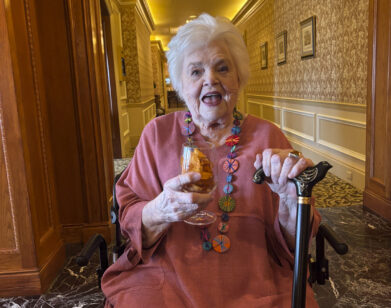Alison Sudol on Screen
ALISON SUDOL IN TOPANGA, CALIFORNIA, MARCH 2015. PHOTOGRAPHY: CHRISTOPHER HENCH. STYLING: SEAN KNIGHT. MAKEUP: SANDY GANZER USING CHANEL BEAUTE FOR JED ROOT. HAIR: TERRI WALKER USING ORIBE FOR JED ROOT.
In the first episode of Dig, USA’s new series set in Jerusalem and helmed by Homeland‘s Gideon Raff, FBI agent Peter Connelly (Jason Isaacs) meets a mysterious American woman named Emma (Alison Sudol). She’s beautiful, young, and a little Manic Pixie Dream Girl, with punk-pink hair. She is living in Jerusalem while she assists a famous archeologist (Richard E. Grant) on a dig beneath the Temple Mount.
Peter and Emma spend a single night wandering around Jerusalem together. Their dynamic is little unsettling, teetering between paternal and sexual. By the the time the pilot’s credits roll, Emma has been murdered and Peter is a suspect. Last night, at the end of the show’s sixth episode, Emma reappeared. Why or how she escaped death, or if she is even really Emma (she looked pretty dead in the photos from the morgue), is unclear. In a show with cross-continental religious conspiracies involving ancient relics and a new Messiah, nothing seems off-limits.
Born and raised in Seattle, Sudol is perhaps most well known as a musician. Between 2007 and 2012, she released three albums under the name A Fine Frenzy, and her songs have appeared in film and television shows such as Dan in Real Life, House M.D., and How I Met Your Mother. This, however, is changing quickly. In addition to Dig, the 30-year-old also had a guest arc on Amazon’s Transparent.
EMMA BROWN: When you first read the script for the pilot, did you think Emma actually died or did they explain it to you?
ALISON SUDOL: I went into the audition, and then into the role, fully thinking that I was going to be done after one episode. Then they said they needed me for months and I didn’t understand: “I die. What are you going to do with me?” When they finally told me, it was quite a shock.
BROWN: You aren’t a clone or a secret twin are you?
SUDOL: I don’t know. You’ll have to watch and find out.
BROWN: What made you want to audition for the show?
SUDOL: It seemed like an adventure. It seemed like something that, as a person, I could really learn from. The way that Israel was described in the first script, the way the character came in and all of these questions that I had about her really got my attention. I was really intrigued. For me, intrigue is a pretty powerful emotion. If you want to know more about a character, if you want to understand how they work, then you have enough curiosity to delve into their skin and their being. That was the biggest pull for me.
BROWN: Did you know who else was going to be involved at the time?
SUDOL: I knew that Jason [Isaacs] was involved and that was really it. I thought he was a really compelling lead actor, so that helped. All of my scenes were with him. I could definitely see myself going on an adventure with him, and learning as an actor from him.
BROWN: How familiar were you with the history of the Temple Mount?
SUDOL: I’d had a cursory education on it in school, but nothing to the degree that I learned after going there and doing research for my character. I don’t feel like I really understood anything very well until I went there. Also, the way that things are portrayed over there in America media, it just doesn’t tell the full story.
BROWN: Did they give you specific books to read?
SUDOL: No, not at all! I was left on my own to figure things out. They gave me just enough information and [then] we were encouraged to do our own research and find out for ourselves. I talked to anybody and everybody that had any sort of connection with archeology or Israel or religious history, be it Jewish, Christian, Muslim. But I didn’t really know anything about my character, except for what you find out throughout the series until the end. The rest was trust and feeling my way in the dark —just blind intuition, really. They didn’t want me to give anything away.
BROWN: Have you ever worked like that before, where you don’t have access to all the information?
SUDOL: Life. [laughs] You think you might know something about yourself or why you act or react in certain ways and then you come to new information and suddenly you see your past and your present in a completely different light. That is how I explored these characters—trying to be really present and get as much information as I could. The more information that I got, the more I understood and also the more questions I had.
BROWN: Did you ever have an imaginary friend when you were growing up?
SUDOL: No, but I could have used one. I wasn’t a very outgoing child. I read a lot of books and the characters in each of the books became like imaginary friends—I immersed myself in the different worlds. I always hated finishing books that I really loved for that reason.
BROWN: Was there a character that you particularly identified with?
SUDOL: Do you remember A Wrinkle in Time? It’s a good one. I think the character’s name is Meg. I just remember she was a very logical, intelligent, advanced girl. I wouldn’t say that I felt like that was who I was, but I wanted to be around her; I wanted to be like her. She had an understanding of science and was incredibly curious—an interesting, complex young girl.
BROWN: You started acting professionally when you were quite young, right? And then you stopped for a while?
SUDOL: I was in a commercial when I was three. My godfather was a director and a producer of commercials. He took me in along with his kids and I couldn’t remember my lines. I giggled my way through the commercial and they kept it. [laughs]
BROWN: What was it for?
SUDOL: Taco Time! A little Northwest taco fast-food joint. I guess I did a couple of things when I was a kid, but they weren’t really acting—I think I walked down a corridor or something. Then I didn’t want to do it at all. I got into it because both my parents were actors and so I went with the flow. [Then I] said, “I can’t handle this, I don’t like auditioning.” I still hate auditioning, but it’s less painful then it was back then.
BROWN: Why is it less painful now?
SUDOL: I think I had a lot of fear, even when I was really young, that I was going to be seen as something that I didn’t want to be. I didn’t really know how to be myself well enough to be comfortable being someone else. Now, as an adult, I have a grounded enough awareness of who I am as a human being and what I’m comfortable exploring and what I’m not interested in exploring. I also have the confidence to say no, and I think those are things that I just didn’t have when I was small. I didn’t want to be a cheerleader, and when you’re young and you’re blonde that’s kind of thrust upon you whether you like it or not. Now I don’t have to worry about that.
BROWN: Do you consider yourself an actress? Or do you still think of yourself as a musician first?
SUDOL: I do consider myself an actress now. I think Dig and Transparent have given me the confidence. I’ve been working as an actress for the past year and a half. It’s something that I have to continue to earn, but I do feel like it’s a part of me. It’s something that I love, and to not acknowledge it would be false.
BROWN: What’s the best advice you’ve gotten when it comes to acting?
SUDOL: On the first day of filming, I was really nervous and jittery. And Jason said, “All you have is the process. All you have is the journey of making something. Once you’re done you have absolutely no control on how it’s received, or if people like it or hate it, or what is done with it. As long as you enjoy the process, then you’ll always be happy.” I really feel like that’s important advice. Sometimes we get so focused on the results that we miss doing it—we miss the adventure of being in the midst of something because we’re looking too far ahead. And really the result doesn’t have much bearing on you; it is the action of it that matters in the end. Not the action—that’s the wrong word—being in it is all that matters, in the moment.
DIG AIRS THURSDAY NIGHTS ON USA.

